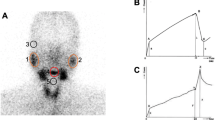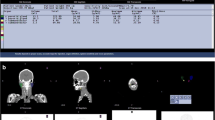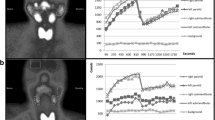Abstract
Purpose
The purpose of the study was to investigate the usefulness of quantitative salivary single-photon emission computed tomography/computed tomography (SPECT/CT) using Tc-99m pertechnetate in Sjögren’s syndrome (SS).
Methods
We retrospectively reviewed quantitative salivary SPECT/CT data from 95 xerostomic patients who were classified as either SS (n = 47, male:female = 0:47, age = 54.60 ± 13.16 y [mean ± SD]) or non-SS (n = 48, male:female = 5:43, age = 54.94 ± 14.04 y) by combination of anti-SSA/Ro antibody, labial salivary gland biopsy, unstimulated whole saliva flow rate, and Schirmer’s test. Thyroid cancer patients (n = 43, male:female = 19:24, age = 46.37 ± 12.13 y) before radioactive iodine therapy served as negative controls. Quantitative SPECT/CT was performed pre-stimulatory 20 min and post-stimulatory 40 min after injection of Tc-99m pertechnetate (15 mCi). The %injected dose at 20 min and the %excretion between 20 and 40 min were calculated for parotid and submandibular glands, generating four quantitative parameters: %parotid uptake (%PU), %submandibular uptake (%SU), %parotid excretion (%PE), and %submandibular excretion (%SE). The most useful parameter for SS diagnosis was investigated.
Results
The uptake parameters (%PU and %SU) were significantly different among the SS, non-SS, and negative controls (p = 0.005 for %PU and p < 0.001 for %SU, respectively), but the excretion parameters (%PE and %SE) were not (p > 0.05 for both). The %PU and %SU were significantly lower in SS than in the negative controls and non-SS (p < 0.05 for all pair-wise comparisons). Additionally, the %SU was significantly lower in non-SS than in the negative controls (p < 0.05). Receiver-operating characteristic analysis revealed that the %SU had the greatest area-under-the curve of 0.720 (95% confidence interval = 0.618–0.807). Using the optimal cut-off value of %SU ≤ 0.07%, SS was identified with a sensitivity of 70.21% and a specificity of 70.83%.
Conclusion
Reduced submandibular uptake of Tc-99m pertechnetate at 20 min (%SU) was proved useful for the diagnosis of SS. Quantitative salivary gland SPECT/CT holds promise as an objective imaging modality for assessment of salivary dysfunction and may facilitate accurate classification of SS.







Similar content being viewed by others
References
Manthorpe R, Frost-Larsen K, Isager H, Prause JU. Sjogren's syndrome. A review with emphasis on immunological features. Allergy. 1981;36:139–53.
Vitali C, Bombardieri S, Jonsson R, Moutsopoulos HM, Alexander EL, Carsons SE, et al. Classification criteria for Sjogren's syndrome: a revised version of the European criteria proposed by the American-European Consensus Group. Ann Rheum Dis. 2002;61:554–8.
Shiboski CH, Shiboski SC, Seror R, Criswell LA, Labetoulle M, Lietman TM, et al. 2016 American College of Rheumatology/European League Against Rheumatism classification criteria for primary Sjogren's syndrome: a consensus and data-driven methodology involving three international patient cohorts. Ann Rheum Dis. 2017;76:9–16.
Vitali C, Bombardieri S, Moutsopoulos HM, Balestrieri G, Bencivelli W, Bernstein RM, et al. Preliminary criteria for the classification of Sjogren's syndrome. Results of a prospective concerted action supported by the European Community. Arthritis Rheum. 1993;36:340–7.
Fujibayashi T, Sugai S, Miyasaka N, Hayashi Y, Tsubota K. Revised Japanese criteria for Sjogren's syndrome (1999): availability and validity. Mod Rheumatol. 2004;14:425–34.
Fox RI, Robinson CA, Curd JG, Kozin F, Howell FV. Sjogren's syndrome. Proposed criteria for classification. Arthritis Rheum. 1986;29:577–85.
Shiboski SC, Shiboski CH, Criswell L, Baer A, Challacombe S, Lanfranchi H, et al. American College of Rheumatology classification criteria for Sjogren's syndrome: a data-driven, expert consensus approach in the Sjogren's International Collaborative Clinical Alliance cohort. Arthritis Care Res. 2012;64:475–87.
Vivino FB, Hermann GA. Role of nuclear scintigraphy in the characterization and management of the salivary component of Sjogren's syndrome. Rheum Dis Clin N Am. 2008;34:973–86 ix.
Schall GL, Anderson LG, Wolf RO, Herdt JR, Tarpley TM Jr, Cummings NA, et al. Xerostomia in Sjogren's syndrome. Evaluation by sequential salivary scintigraphy. JAMA. 1971;216:2109–16.
Schall GL, Larson SM, Anderson LG, Griffith JM. Quantification of parotid gland uptake of pertechnetate using a gamma scintillation camera and a “region-of-interest” system. Am J Roentgenol Radium Therapy, Nucl Med. 1972;115:689–97.
Solans R, Bosch JA, Galofre P, Porta F, Rosello J, Selva-O'Callagan A, et al. Salivary and lacrimal gland dysfunction (sicca syndrome) after radioiodine therapy. J Nucl Med. 2001;42:738–43.
Caglar M, Tuncel M, Alpar R. Scintigraphic evaluation of salivary gland dysfunction in patients with thyroid cancer after radioiodine treatment. Clin Nucl Med. 2002;27:767–71.
Sugihara T, Yoshimura Y. Scintigraphic evaluation of the salivary glands in patients with Sjogren's syndrome. Int J Oral Maxillofac Surg. 1988;17:71–5.
Hakansson U, Jacobsson L, Lilja B, Manthorpe R, Henriksson V. Salivary gland scintigraphy in subjects with and without symptoms of dry mouth and/or eyes, and in patients with primary Sjogren's syndrome. Scand J Rheumatol. 1994;23:326–33.
Umehara I, Yamada I, Murata Y, Takahashi Y, Okada N, Shibuya H. Quantitative evaluation of salivary gland scintigraphy in Sjorgen's syndrome. J Nucl Med. 1999;40:64–9.
Aung W, Yamada I, Umehara I, Ohbayashi N, Yoshino N, Shibuya H. Sjogren's syndrome: comparison of assessments with quantitative salivary gland scintigraphy and contrast sialography. J Nucl Med. 2000;41:257–62.
Nishiyama S, Miyawaki S, Yoshinaga Y. A study to standardize quantitative evaluation of parotid gland scintigraphy in patients with Sjogren's syndrome. J Rheumatol. 2006;33:2470–4.
SNM guideline. In http://www.snmmi.org/ClinicalPractice/content.aspx?ItemNumber=6414&navItemNumber=10790.
EANM guideline. In http://www.eanm.org/publications/guidelines/index.php?navId=37.
Ritt P, Vija H, Hornegger J, Kuwert T. Absolute quantification in SPECT. Eur J Nucl Med Mol Imaging. 2011;38(Suppl 1):S69–77.
Bailey DL, Willowson KP. An evidence-based review of quantitative SPECT imaging and potential clinical applications. J Nucl Med. 2013;54:83–9.
Suh MS, Lee WW, Kim YK, Yun PY, Kim SE. Maximum standardized uptake value of (99m)Tc hydroxymethylene diphosphonate SPECT/CT for the evaluation of temporomandibular joint disorder. Radiology. 2016;280:890–6.
Lee H, Kim JH, Kang YK, Moon JH, So Y, Lee WW. Quantitative single-photon emission computed tomography/computed tomography for technetium pertechnetate thyroid uptake measurement. Medicine (Baltimore). 2016;95:e4170.
Kim HJ, Bang JI, Kim JY, Moon JH, So Y, Lee WW. Novel application of quantitative single-photon emission computed tomography/computed tomography to predict early response to methimazole in Graves’ disease. Korean J Radiol. 2017;18:543–50.
Kim J, Lee HH, Kang Y, Kim TK, Lee SW, So Y, et al. Maximum standardised uptake value of quantitative bone SPECT/CT in patients with medial compartment osteoarthritis of the knee. Clin Radiol. 2017;72:580–9.
Kang YK, Park S, Suh MS, Byun SS, Chae DW, Lee WW. Quantitative single-photon emission computed tomography/computed tomography for glomerular filtration rate measurement. Nucl Med Mol Imaging. 2017;51:338–46.
Kim JY, Kim JH, Moon JH, Kim KM, Oh TJ, Lee DH, et al. Utility of quantitative parameters from single-photon emission computed tomography/computed tomography in patients with destructive thyroiditis. Korean J Radiol. 2018;19:470–80.
Kang JY, Jang SJ, Lee WW, Jang SJ, Lee YJ, Kim SE. Evaluation of salivary gland dysfunction using salivary gland scintigraphy in Sjogren's syndrome patients and in thyroid cancer patients after radioactive iodine therapy. Nucl Med Mol Imaging. 2011;45:161–8.
Haugen BR, Alexander EK, Bible KC, Doherty GM, Mandel SJ, Nikiforov YE, et al. 2015 American Thyroid Association management guidelines for adult patients with thyroid nodules and differentiated thyroid cancer: The American Thyroid Association Guidelines Task Force on Thyroid Nodules and Differentiated Thyroid Cancer. Thyroid. 2016;26:1–133.
Atkinson JC, Grisius M, Massey W. Salivary hypofunction and xerostomia: diagnosis and treatment. Dent Clin N Am. 2005;49:309–26.
Vitali C, Moutsopoulos HM, Bombardieri S. The European Community Study Group on diagnostic criteria for Sjogren's syndrome. Sensitivity and specificity of tests for ocular and oral involvement in Sjogren's syndrome. Ann Rheum Dis. 1994;53:637–47.
Nakamura T, Oshiumi Y, Yonetsu K, Muranaka T, Sakai K, Kanda S. Salivary SPECT and factor analysis in Sjogren's syndrome. Acta Radiol. 1991;32:406–10.
van Acker F, Flamen P, Lambin P, Maes A, Kutcher GJ, Weltens C, et al. The utility of SPECT in determining the relationship between radiation dose and salivary gland dysfunction after radiotherapy. Nucl Med Commun. 2001;22:225–31.
Chen J, Zhao X, Liu H, Zhou S, Yang Y, Li S, et al. A point-scoring system for the clinical diagnosis of Sjogren's syndrome based on quantified SPECT imaging of salivary gland. PLoS One. 2016;11:e0155666.
Hermann GA, Vivino FB, Shnier D, Krumm RP, Mayrin V, Shore JB. Variability of quantitative scintigraphic salivary indices in normal subjects. J Nucl Med. 1998;39:1260–3.
Stephens LC, Schultheiss TE, Price RE, Ang KK, Peters LJ. Radiation apoptosis of serous acinar cells of salivary and lacrimal glands. Cancer. 1991;67:1539–43.
Raza H, Khan AU, Hameed A, Khan A. Quantitative evaluation of salivary gland dysfunction after radioiodine therapy using salivary gland scintigraphy. Nucl Med Commun. 2006;27:495–9.
Hermann GA, Vivino FB, Goin JE. Scintigraphic features of chronic sialadenitis and Sjogren's syndrome: a comparison. Nucl Med Commun. 1999;20:1123–32.
Saito T, Fukuda H, Horikawa M, Ohmori K, Shindoh M, Amemiya A. Salivary gland scintigraphy with 99mTc-pertechnetate in Sjogren's syndrome: relationship to clinicopathologic features of salivary and lacrimal glands. J Oral Pathol Med. 1997;26:46–50.
Miyake H, Matsumoto A, Hori Y, Takeoka H, Kiyosue H, Hori Y, et al. Warthin's tumor of parotid gland on Tc-99m pertechnetate scintigraphy with lemon juice stimulation: Tc-99m uptake, size, and pathologic correlation. Eur Radiol. 2001;11:2472–8.
Adams BK, Al Attia HM, Parkar S. Salivary gland scintigraphy in Sjogren's syndrome: are quantitative indices the answer? Nucl Med Commun. 2003;24:1011–6.
Loutfi I, Nair MK, Ebrahim AK. Salivary gland scintigraphy: the use of semiquantitative analysis for uptake and clearance. J Nucl Med Technol. 2003;31:81–5.
Nakada K, Ishibashi T, Takei T, Hirata K, Shinohara K, Katoh S, et al. Does lemon candy decrease salivary gland damage after radioiodine therapy for thyroid cancer? J Nucl Med. 2005;46:261–6.
Funding Source
This work was supported by the Basic Science Research Program through the National Research Foundation of Korea (NRF) and funded by the Ministry of Education (2015R1D1A1A01059146).
Author information
Authors and Affiliations
Corresponding author
Ethics declarations
Conflicts of Interest
Jihyun Kim, Hyunjong Lee, Hwanhee Lee, Ji-In Bang, Yeon-koo Kang, Sungwoo Bae, Yoo Sung Song, and Won Woo Lee declare that they have no conflicts of interest.
Ethical Approval
The study was approved by an institutional review board (IRB) and was performed in accordance with the ethical standards set in the 1964 Declaration of Helsinki and its later amendments.
Informed Consent
The need for patient’s informed consent was waived by the IRB.
Rights and permissions
About this article
Cite this article
Kim, J., Lee, H., Lee, H. et al. Quantitative Single-Photon Emission Computed Tomography/Computed Tomography for Evaluation of Salivary Gland Dysfunction in Sjögren’s Syndrome Patients. Nucl Med Mol Imaging 52, 368–376 (2018). https://doi.org/10.1007/s13139-018-0547-4
Received:
Revised:
Accepted:
Published:
Issue Date:
DOI: https://doi.org/10.1007/s13139-018-0547-4




